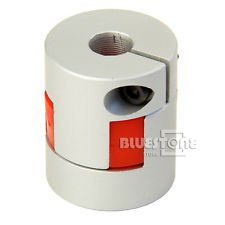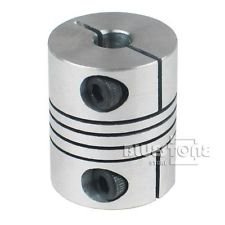- Joined
- Apr 30, 2012
- Messages
- 2,401
ok i'll give this a basic shot
a stepper motor is controlled by pulses (steps) the common type has 200 steps in 1 revolution or 1 step every 1.8 degrees. microstepping is dividing 1 revolution into smaller steps with electronics. 1/2 stepping the motor would double the number of pulses it takes to complete 1 revolution 0r 400 pulses or .9 degrees per pulse. the greater number of pulses the motor uses the smoother it runs but because it does not reach full current in the time allowed per pulse the torque reduces. because the pc is limited in its speed it can send the pulses through a parallel port the controller handles the higher speeds. the higher the pulse the less torque the motor has but the accuracy of the motion increases.
if you were to use a stepper motor at the 200 steps per revolution mode connected to a 5 thread per inch shaft to move a milling table for example then one inch is only capable of being divided into 1000 steps ( 200 x 5tpi )or .001 per step. this sounds ok for most uses but the downside is that at slow feed speeds the steps are a series of hard thumps and vibration can be severe at some speed due to harmonics in the motor and drive parts. this all comes back to surface finish loss. now if you microstep that same 5tpi shaft at 2000 steps per revolution then it would require 10000 steps to move the table 1 inch. the series of thumps now is a steady buzzing. the downside is to get the torque at higher speeds you may need a larger motor or higher voltage. the pulses (steps) are too fast for the motor to reach full current in the time allowed per step.
most stepper motors are marked with voltage and amps, the amps are what is required to reach the advertised torque. the voltage is missleading and can be as much as 10 times what is marked. voltage is electrical pressure and because the step is so fast the motor does not have time to reach full current we raise the voltage ( pressure ) to make the motor reach the required amperage faster.
so a motor marked at 8v may be powered with a power supply putting out 80v.
the other advantage of microstepping is accuracy the smaller we divide an inch the more accurate we can move the axis.
steve
a stepper motor is controlled by pulses (steps) the common type has 200 steps in 1 revolution or 1 step every 1.8 degrees. microstepping is dividing 1 revolution into smaller steps with electronics. 1/2 stepping the motor would double the number of pulses it takes to complete 1 revolution 0r 400 pulses or .9 degrees per pulse. the greater number of pulses the motor uses the smoother it runs but because it does not reach full current in the time allowed per pulse the torque reduces. because the pc is limited in its speed it can send the pulses through a parallel port the controller handles the higher speeds. the higher the pulse the less torque the motor has but the accuracy of the motion increases.
if you were to use a stepper motor at the 200 steps per revolution mode connected to a 5 thread per inch shaft to move a milling table for example then one inch is only capable of being divided into 1000 steps ( 200 x 5tpi )or .001 per step. this sounds ok for most uses but the downside is that at slow feed speeds the steps are a series of hard thumps and vibration can be severe at some speed due to harmonics in the motor and drive parts. this all comes back to surface finish loss. now if you microstep that same 5tpi shaft at 2000 steps per revolution then it would require 10000 steps to move the table 1 inch. the series of thumps now is a steady buzzing. the downside is to get the torque at higher speeds you may need a larger motor or higher voltage. the pulses (steps) are too fast for the motor to reach full current in the time allowed per step.
most stepper motors are marked with voltage and amps, the amps are what is required to reach the advertised torque. the voltage is missleading and can be as much as 10 times what is marked. voltage is electrical pressure and because the step is so fast the motor does not have time to reach full current we raise the voltage ( pressure ) to make the motor reach the required amperage faster.
so a motor marked at 8v may be powered with a power supply putting out 80v.
the other advantage of microstepping is accuracy the smaller we divide an inch the more accurate we can move the axis.
steve



